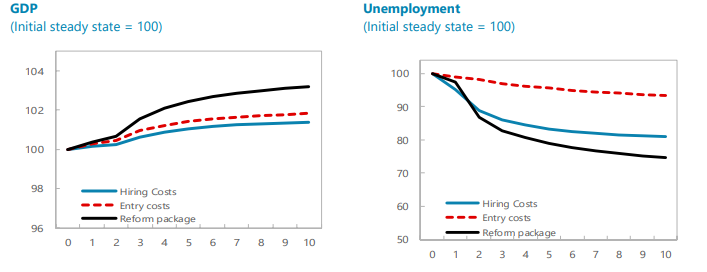Introduction
Promoting sustainable development is one of the most relevant global-scale tasks today. A vision of what sustainable development means is set out in a new UN agenda for sustainable development, which aims to meet the targets of poverty eradication, human prosperity, and well-being by 2030 while protecting the environment. The following Sustainable Development Goals (SDGs) are especially relevant: 4) Ensuring inclusive and equitable quality education; 5) Ensuring gender equality; 10) Reducing inequality within and between countries. Moreover, for developing countries such as Morocco, these goals are especially crucial, as achieving them would provide the basis for further sustainable development in the areas of building social capital and protecting the environment.
SDG Goals for Consideration
Goal 4 – Ensure inclusive and equitable quality education and promote lifelong learning opportunities for all. Source: UN. “The Sustainable Development Goals Report 2019.”
Goal 10. Reduce inequality within and among countries. Source: UN. “The Sustainable Development Goals Report 2019.”
Goal 14 – Conserve and sustainably use the oceans, seas and marine resources for sustainable development. Source: UN. “The Sustainable Development Goals Report 2019.”
SDGs achievement in Morocco
In recent years, Morocco devoted strong efforts to enable sustainable development in the country and meet some important sustainable development goals. However, evident gaps and challenges are observed, in particular, in meeting SDG4, SDG5, and SDG10.
Meanwhile, achieving the SDG4 targets is critical for economic growth and poverty reduction. Education contributes to a range of social and non-market benefits, such as improved child well-being and health outcomes, increased consumer choice, and better social capital.
Below, the dynamics of three indicators for SDG4 is given:
- Net Enrollment Ratio (Primary Education) (%), 2017 (Fig. 1).

Net enrollment ratio in primary education grew 2.44% – to 96.8% as of 2017. In retrospect, net enrollment ratio in primary education in Morocco reached its maximum in 2017 while the lowest value was observed in1971 – 36.9% (Mansouri and Moumine 11). Morocco occupies 20th place among 80 countries in terms of net enrollment ratio in primary education (Mansouri and Moumine 12).
- Dynamics of youth functional literacy (Fig. 2).
Dynamics of youth functional literacy in Morocco and other African countries, 2000-2018

- Percentage of population in a given age group achieving at least a fixed level of proficiency in functional (a) literacy and (b) numeracy skills

As to SDG10, some important steps were made regarding reducing inequality in Morocco. The following results were achieved (Dadush and Saoudi 3):
- Poverty rate of $ 1.9 per day 0.9%
- Poverty rate at $ 3.2 a day 7.3%
- Poverty rate at the national poverty line 4.8%
- Share of total income of the poorest 10% 2.7%
- Share in total income of the richest 10% 31.9%
- Some indicators related to SDG10 are presented below (Fig. 4 – Fig. 6).
- Proportion of people living below 50 per cent of median income.

- Recruitment cost borne by employee.

- Labor share of GDP.

As to SDG14, in Morocco, one can see how the nationwide electrification achieved in 2015 is helping to increase water availability. Integrated water and energy initiatives here began to be implemented even before the SDGs were adopted (). While different agencies are responsible for developing water and energy policies, some of these programs involve coordinated activities.
- Coverage of protected areas in relation to marine areas

- Progress by countries in the degree of implementation of international instruments aiming to combat illegal, unreported and unregulated fishing. Morocco is among African countries with the highest level of such implementation (Fig. 8).

- Progress by countries in the degree of application of a legal/regulatory/policy/institutional framework which recognizes and protects access rights for small-scale fisheries (Fig. 9).

Works Cited
Ali, Abdelaaziz, and Uri Dadush. “Deindustrialization and Employment in Morocco.” OCP Policy Center Policy Brief, November 2018, PB-18/34. Web.
Dadush, Uri, and Hamza Saoudi. Inequality in Morocco: An International Perspective. Policy Center for the New South, 2019.
Ennaji, Moha. “Morocco’s Experience with Gender Gap Reduction in Education.” Gender and Women’s Studies, vol. 2, no. 1, 2018, pp. 1-18.
Finley, Carmel. All the Fish in the Sea: Maximum Sustainable Yield and the Failure of Fisheries Management. University of Chicago Press, 2019.
IMF. Country Report No. 19/230. Web.
Mansouri, Zoulal, and Mohamed El Amine Moumine. “Primary and Secondary Education in Morocco: From Access to School into Generalization to Dropout.” International Journal of Evaluation and Research in Education (IJERE), vol. 6, no. 1, 2017, pp. 9-16. Web.
Moutchou, Najat Ei. “Sustainable Marine Aquaculture in Morocco: Siting Guidelines, Monitoring Standards & Environmental Models for Coastal Finfish Aquaculture.” Project Development of Siting, Modeling and Monitoring Guidelines for Coastal Finfish Aquaculture in Morocco, 2019. Web.
Source: Robbins, Michael, and Kathrin Thomas. “Women in the Middle East and North Africa: A Divide between Rights and Roles.” Arab Barometer – Wave IV, 2020.
Saoudi, Khadija et al. “Student Achievement in Moroccan Student Achievement in Moroccan Educational Reforms: A Significant Gap Between Aspired Outcomes and Current Practices. Interchange, vol. 51, 2020, pp. 117–136.